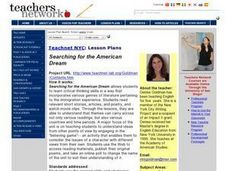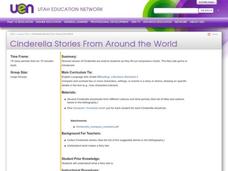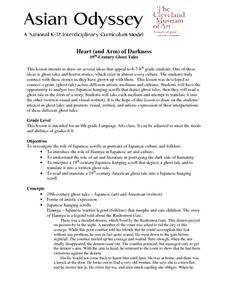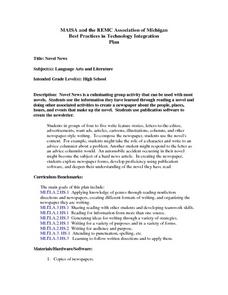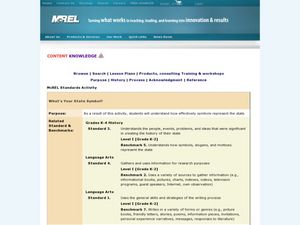Curated OER
Haiku Poetry
Third graders write their own haiku poem after a lesson on the history and format of a haiku. In this poetry lesson plan, 3rd graders write a haiku with the correct lines and symbols.
Curated OER
Haiku: Observation and Writing in the Japanese Garden
Learners observe a Botanical Gardens. Upon returning to the classroom, students write their own Haiku based on their observations.
Curated OER
Searching For The American Dream
Ninth graders explore the meaning of the American dream and how it has been explained in various forms. After reading various immigrant accounts, 9th graders use poetry and writing to explain how different cultures view the American...
Curated OER
Nursery Rhymes
Students recall details of nursery rhyme read by teacher, identify main characters, and demonstrate knowledge of poem by creating concept map about story that includes title, clip art, and changes in font and color.
Curated OER
Ode to a Nightingale
Learners read poems about Tuberculosis by John Keats. Using the poems, they identify similies, metaphors, personification and imagery. In groups, they make connections about the author's outlook on life and how his disease impacted his...
Curated OER
Cinderella Stories From Around the World
Fifth graders are read a variety of Cinderella stories from around the world. In groups, they complete a comparison chart for each story and how it compares to the American version. To end the lesson, they participate in a fairy tale...
Curated OER
Reading Lesson Plan
Tenth graders read the poem "Still I Rise" and discuss the different ways it can be told and read and brought to life. In this poetry lesson plan, 10th graders read aloud and silently, and compare different works of poetry.
Curated OER
Memior: The Stuff of Our Lives
Fourth graders reflect upon the significance of remembered events and to keep a "notebook" of their thoughts and feelings. They read books that exemplify memior writing. They write their memiors, taking it through the writing process.
Curated OER
Comparing Characters Across Two Short Stories
Ninth graders listen to a read aloud of two short stories focusing on literary devices. The write about the settings and realism of the stories, and decide each main character handles the conflict he faces with nature.
Curated OER
Heart (and Arm) of Darkness
Learners read and translate a 19th-century American ghost tale into a Japanese hanging scroll in this exciting lesson for middle-level Language Art classes. The lesson can be completed in four or five days.
Curated OER
Novel News
Young scholars, working in groups create a newspaper based on the events that take place in a novel. Groups complete sections of the newsletter based on criteria and publish it using newsletter publishing software.
Curated OER
Outline of a Legend/Folk Tale
Students create outlines of folk tales and legends. They read a folk tale or legend in the target language. They complete an outline of the key events of the story including the main characters, plot, story elements and theme or moral.
Curated OER
Most Wanted Villians
Students review the characteristics of various characters in fairytales. As a class, they review the story details and create a concept map using a software program. They create their own wanted poster of the villians in the fairytale to...
Curated OER
My Favorite Things
Pupils identify "masterpieces" and mass-produced objects. They explain why they value a given object and determine what physical materials were used to create the objects. They create a class book featuring objects that they value.
Curated OER
Using Picture Mapping to Improve Student Comprehension
Students draw pictoral representations of a reading selection they read in order to recall information. In this picture mapping lesson plan, students use pictures to comprehend what they read and sequence the pictures as well.
Curated OER
The Great Depression and Now: The Migrant Worker Experience
Students identify the concerns of people caught in desperate times during the Great Depression. They make connections between The Grapes of Wrath and historical images from the Great Depression. Students make connections between the...
Curated OER
Writing a Narrative
Sixth graders read the short story "Eleven". They write a narrative composition focusing on the use of voice. Students use a computer to create a pre-writing graphic organizer and type their final draft.
Curated OER
Identity in A Raisin in the Sun
Ninth graders read the play, "A Raisin in the Sun," and participate in a class discussion about "identity." They discuss racial identity and examine and interpret how community influences a personal identity. They demonstrate how...
Curated OER
Guideline For Book Reports
Students are introduced to the guidelines regarding their upcoming book report. As a class, they brainstorm opening statements to grab the reader's attention and what type of information to present. They must include an evaluation of...
Curated OER
Fate vs. Mind: A Macedonian Folk Tale
Learners examine the work of Carla Bachechi as a Peace Corp volunteer in Macedonia. Individually, they read various folktales from the country and break into groups to discuss how it is different than a novel. To end the lesson, they...
Curated OER
Students Information And Interest Survey
In this personal information instructional activity, students fill out this form to give details about their personal history, prior experiences and preferences. This could be used for information gathering or as an icebreaker activity.
Curated OER
What's Your State Symbol?
Students explore their state symbols. In this symbolism lesson, students use a variety of resources to research the symbols that represent their state. Students discover the state flower, state flag, and state bird.
Curated OER
Mice Squeak; We Speak
Students create a poster. In this vocabulary lesson, students use vocabulary words such as squeak, creak, squeal, squawk and quack to identify the sounds and noises of each word. Students come up with rhyming words and create a word...
Curated OER
Step-by-Step to the Final Destination
Students write their own radio plays. For this writing process lesson, students script their own scary radio plays based on the radio plays they read in class in previous lessons. Students also perform the plays for their classmates.




